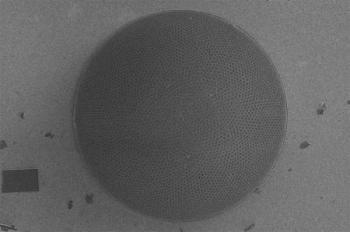Feb 10 2016
Diatoms are algae organisms comprising a single cell, and are sized from 30 to 100 millionths of a meter in diameter. They are scattered all-over the oceans, and have a hard shell made of silica. This shell resembles a flattened and wide cylinder like that of a tambourine.
 Diatoms are uni-cellular algae that form an exterior silica shell. These shells are porous and display symmetry across several length scales. Credit: Zachary Aitken
Diatoms are uni-cellular algae that form an exterior silica shell. These shells are porous and display symmetry across several length scales. Credit: Zachary Aitken
Recently, a research team from the laboratory of Julia Greer discovered that these shells exhibit a specific strength higher than any known biomaterials such as teeth, antlers, and bones. The specific strength is defined the strength at which a structure tends to break with regard to its density.
The results of this new discovery were published in the February 9, 2016, issue of Proceedings of the National Academy of Science. Julia Greer is a professor of materials science and mechanics in Caltech's Division of Engineering and Applied Science.
A diatom’s shell also known as frustule is porous as it contains holes that are arranged in a honeycomb-like pattern. There exist a number of theories on the functioning of these complex shell designs, and some of these theories highlight that theses holes help controlling the flow of fluid, or even help the organisms to obtain nutrients. Greer and her team of researchers suggest that the holes also serve as stress concentrators-“flaws” in the material that are capable of suppressing the growth of cracks, which can cause the collapse of the entire organism.
Silica is a strong but brittle material. For example, when you drop a piece of glass, it shatters. But architecting this material into the complex design of these diatom shells actually creates a structure that is resilient against damage. The presence of the holes delocalizes the concentrations of stress on the structure.
Julia Greer, Caltech
The research team plans to use design concepts from diatoms to develop flexible, bioinspired artificial structures.